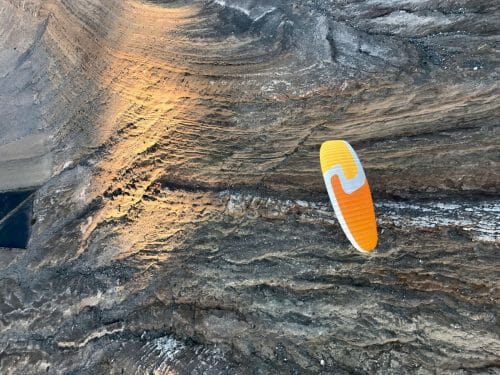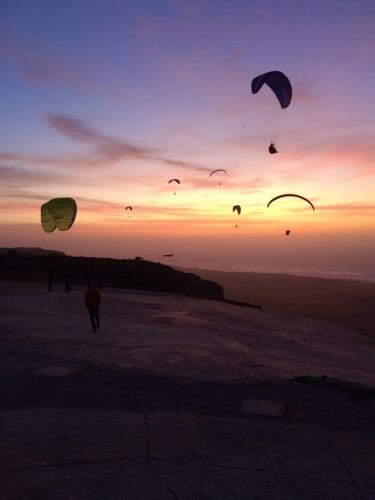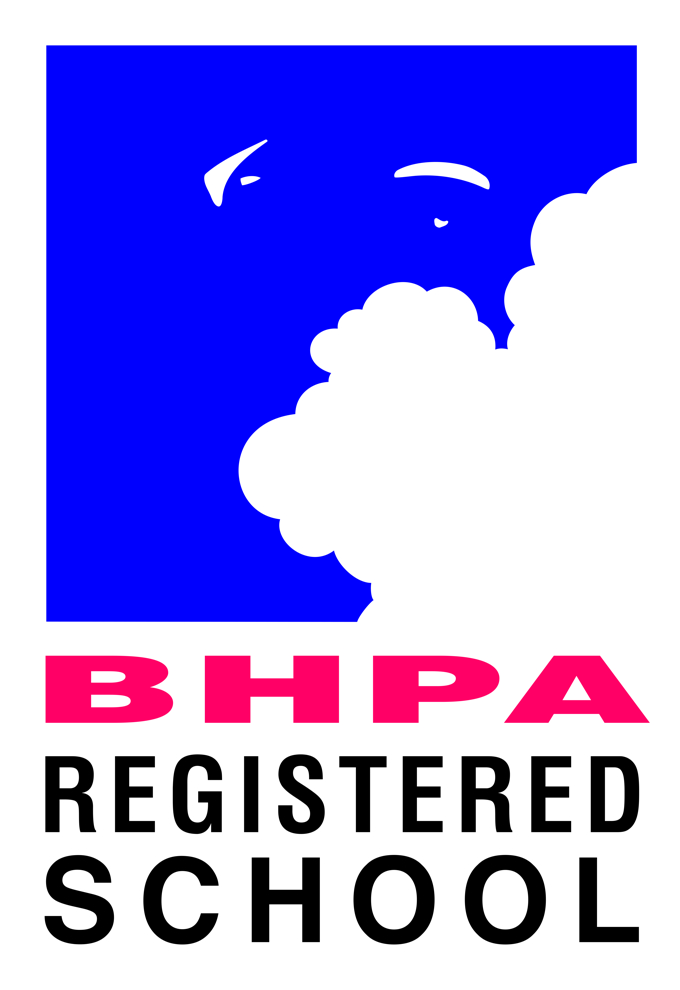How to start paragliding or paramotoring
We are a Sherborne based paramotor and paragliding school and if you’d like to learn to fly, we’d love to teach you. We are a British Hang gliding and Paragliding Association (BHPA) registered school so offer the highest standards.
Let me explain the differences and what’s involved in paragliding and paramotoring; you can do either one or many people do both.
Paragliding is probably the simplest form of aviation and to do this you’ll need 4 basic pieces of equipment; a helmet, harness (seat), a glider and a reserve parachute system. Depending on a number of factors, the total weight of the equipment is usually around 12 Kg and a complete new set of equipment will cost around £4000. We take off from hills (or mountains)
The BHPA splits the training for paragliding into 2 parts, the beginner course, Elementary Pilot (EP) and the second level course, Club Pilot (CP).
On your first day you will start by learning about the equipment and how to inspect it and prepare it for flight. You will then move on to inflating and controlling your glider while on the ground. Generally, you’ll have spent a half or full day before you’re ready to make your first flight and this will be about a meter above the ground. As your take-offs and landings become better you make gradually bigger flights and typically by the end of your second day you’ll be 15 meters or more above the ground and will be practising making turns. A beginners course takes about 5 days for most people and by the end of this you’ll be capable of launching yourself in gentle conditions, steering your glider and landing very gently under full control. You will have been 50 or more meters above the ground!
 Before you can fly independently you’ll need to complete the second level course, CP and this will involve practising various things like extending the range of conditions in which you fly, improving your glider control and learning how to use rising air to stay airborne for many minutes or even hours. Completing CP generally takes about a week and by the end if it you’ll be able to fly independently.
Before you can fly independently you’ll need to complete the second level course, CP and this will involve practising various things like extending the range of conditions in which you fly, improving your glider control and learning how to use rising air to stay airborne for many minutes or even hours. Completing CP generally takes about a week and by the end if it you’ll be able to fly independently.
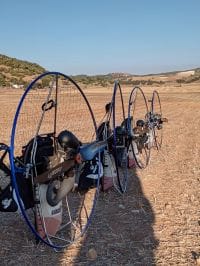 The equipment that you’ll need for paramotoring is slightly different from paragliding. You’ll need a paramotor which will come with a harness already attached, a glider, a helmet with ear defenders and comms built in as well as a reserve parachute system.
The equipment that you’ll need for paramotoring is slightly different from paragliding. You’ll need a paramotor which will come with a harness already attached, a glider, a helmet with ear defenders and comms built in as well as a reserve parachute system. 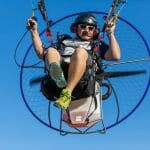 A new set of paramotor equipment will cost you around £10,000. The paramotor with a full tank of fuel will weigh 25 – 28 Kg but once you inflate your glider it will take the weight so you won’t have to run supporting that amount of weight. Again, landings are very gently because the wing is supporting the weight of the motor and if gradually is transferred yo you after you land. With paramotoring we take off from a flat field and using a petrol driven propeller we can climb to many thousand feet if we wish. Paramotor training starts in exactly the same way as paragliding although the paramotor qualification isn’t split into 2 parts like paragliding. You’ll start with learning about the equipment, how to inspect and prepare it. You’ll do lots of practice inflating and controlling your glider and some small flights all without the motor. Once you’ve mastered the basic skills you’ll be introduced to the motor: the safety checks, fuleing it and the warm up procedure. The next step is to develop a good body position for take off and this is done with the motor running. Before you make your first flight you’ll have practised aborting take-offs which will help you get used to using the thrust. All of your first flights will be flying a circuit around our airfield at about 500 feet. By the end of your course you’ll have completed flights out of circuit, engine failure practice, spot landing and much more and will be ready to fly independently.
A new set of paramotor equipment will cost you around £10,000. The paramotor with a full tank of fuel will weigh 25 – 28 Kg but once you inflate your glider it will take the weight so you won’t have to run supporting that amount of weight. Again, landings are very gently because the wing is supporting the weight of the motor and if gradually is transferred yo you after you land. With paramotoring we take off from a flat field and using a petrol driven propeller we can climb to many thousand feet if we wish. Paramotor training starts in exactly the same way as paragliding although the paramotor qualification isn’t split into 2 parts like paragliding. You’ll start with learning about the equipment, how to inspect and prepare it. You’ll do lots of practice inflating and controlling your glider and some small flights all without the motor. Once you’ve mastered the basic skills you’ll be introduced to the motor: the safety checks, fuleing it and the warm up procedure. The next step is to develop a good body position for take off and this is done with the motor running. Before you make your first flight you’ll have practised aborting take-offs which will help you get used to using the thrust. All of your first flights will be flying a circuit around our airfield at about 500 feet. By the end of your course you’ll have completed flights out of circuit, engine failure practice, spot landing and much more and will be ready to fly independently.
FAQ,s
1. Do I have to be very fit to paraglide or paramotor?
A: You will need a basic level of fitness for both but you don’t need to be very fit. Aviation medicals are not required for either paragliding or paramotoring.
2. Can I fly where ever I want?
A: We have to follow air law so there are places that we must avoid but you will learn about this on your course.
3. Can I buy second hand equipment and is it a good idea?
A: The latest design equipment will always be the safest and easiest to use. I would NEVER consider a second hand reserve parachute system and any second hand wing, I would want to have tested before I bought it. Over the years we have had students turn up with old paramotors and the original manufacturer no longer exists and it’s impossible to get spare parts and wings that have deteriorated so badly that they’re porous and unsafe to fly.
During your training we will supply all the equipment and will help you find what’s right for you when you are ready to buy.
4. Why don’t we run more UK based courses?
A: We used to but the UK weather makes it incredibly difficult. In the UK there are often long gaps between training sessions because of the weather (sometimes months) so there is always a remedial element and it just takes forever. We do run courses in the summer months in the UK but teach abroad for the rest of the year. Additionally, you’ll have an amazing holiday on our trips abroad and non-flying partners are always welcome.
5. Are there any exams on the courses?
A: Yes, but we’ll supply you with a comprehensive set of notes as well as lecturing you on the subjects.
6. If I’m flying a paramotor and my engine stops will I fall?
A: No! If your engine stops working you are still attached to your glider and it will continue to fly normally. Effectively, you would be flying a paraglider and in any case, the normal way to land is to switch off your engine when you’re about 50ft above the ground.
7. How long is a paragliding flight?
A: This is very much down to the conditions but commonly we make flights of 30 mins up to a couple hours but people have flown over 600 Km in a single flight and spent more than 10 hours in the air!
8. How far can I fly on a pararmotor?
A: If we imagine there is no wind because a headwind or tailwind will change it, a 10l tank will give you just over 3 hours and that would equate to about 100 – 120 Km. It is possible to get a larger tank or in flight refuelling systems that will extend this distance.
9. How transportable are paragliders and paramotors?
A: A paraglider fits in a rucksack and all of the equipment together weighs 10 or 12 Kg and is easily taken on international flights. A paramotor will break down and will fit in the boot of a small car. People do take them on commercial flights but you would have to completely purge the fuel system and remove all traces of fuel fumes.
10. Why do I need to be a member of the BHPA (British Hang gliding and Paragliding Association )?
A: There are so many reasons. The BHPA is the national governing body for both paragliding and paramotoring. All schools are inspected annually and they run instructor courses and exams in order to keep the standards as high as possible. One of the many benefits of your membership is that you will have 3rd party liability insurance which all landowners will insist on if you’re using their land.
11. Ok, I’m interested, how do I start?
A: Take a look at our course page and select the course that you’re interested in. We’re always happy to talk to you (+44 (0)7833 107902) and advise you.

